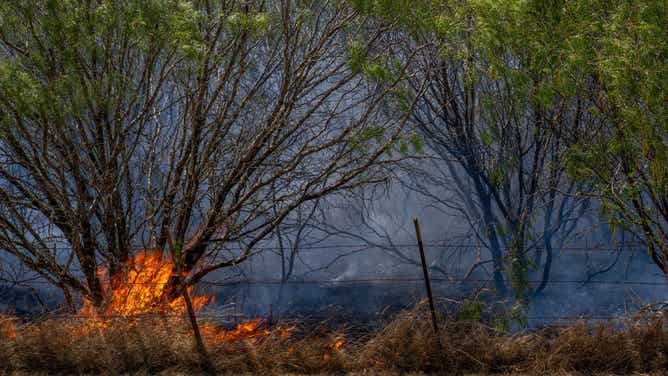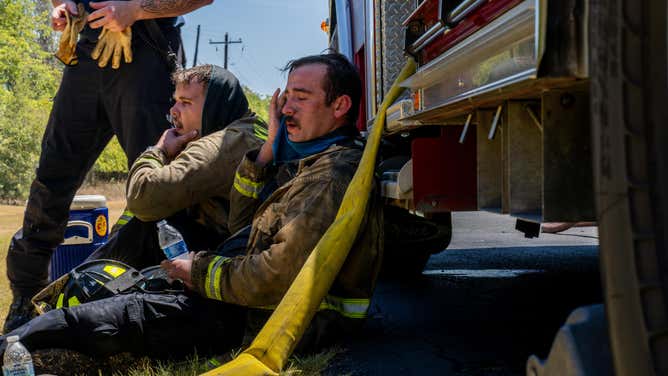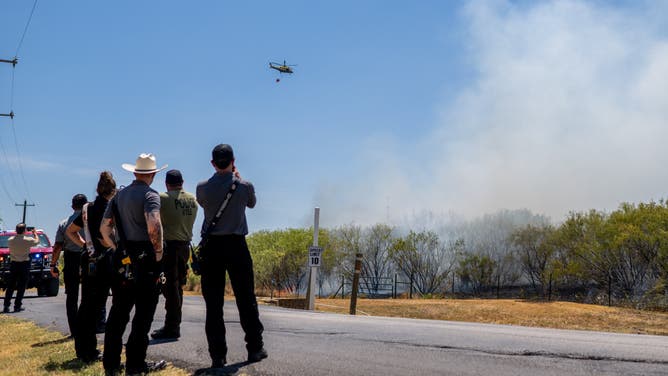Relentless Texas heat wave sets stage for 'critical' wildfire dangers this week
As of Wednesday, Texas A&M Forest Service has counted 140 fires burning nearly 14,000 acres in the past seven days.
FILE: Active Fire Weather Warnings in place for Texas where 2 firefighters were injured
Fire Weather Warnings are in place across Texas, Oklahoma and parts of the Pacific Northwest. Gusting winds, hot temperatures and low dew point levels are fueling the fire danger across Texas and Oklahoma.
COLLEGE STATION, Texas – The summer heat wave, along with increased wind speeds in the forecast, have created a dangerous environment for wildfires across parts of the Lone Star State.
For the past two weeks, areas of Texas have already been experiencing elevated fire weather, with triple-digit temperatures, relative humidity under 25% and wind speeds of 10-15 mph.
In fact, as of Wednesday, Texas A&M Forest Service has counted 140 fires burning nearly 14,000 acres of the Lone Star State in the past seven days. This week, however, the fire hazard is expected to escalate.
Why Texas is under a 'critical' fire risk

The remnants of a wildfire are seen burning on August 08, 2023 in Hays County, Texas.
(Brandon Bell / Getty Images)
"Those wind speeds are going to increase by about 5-10 miles an hour, and it's going to push us into critical fire weather," said Logan Scherschel, fire analyst with Texas A&M Forest Service.
"Subtle increases of 5-10 miles an hour in wind speeds during the summer fire season have huge impacts on fire spread and fire growth," he added.
TEXAS WILDFIRE DESTROYS SEVERAL HOMES AS HEAT, DRY WEATHER CONSPIRE AGAINST FIREFIGHTERS
One of the main reasons for this "critical" fire risk is the amount of fuel currently available for wildfires.
The fuel comes in the form of grasses, shrubs and trees that have dried out, due to six weeks of persistent, triple-digit temperatures, according to Scherschel. Additionally, a large amount of this fuel is available, as the wet spring allowed the plant life to grow abundantly prior to the heat wave.

Members of the Hays County Emergency Service Districts and the Kyle and Buda Fire Departments rest together while combating a wildfire during an excessive heat warning on August 08, 2023 in Hays County, Texas.
(Brandon Bell / Getty Images)
"Right now, with the triple-digit temperatures, all that heating of the surface creates a low-level instability, and it creates a very efficient burning environment for wildfires," Scherschel said. "All the fuel’s preheated, basically, by these triple-digit temperatures."
2 TEXAS FIREFIGHTERS INJURED AS FIRE WEATHER DANGER INCREASES ACROSS PLAINS
This sets the stage for extreme fire behavior, allowing the fires to easily transition from burning grasses and leaf litter to creeping their way up into the dry canopies of trees. Scherschel likened lower-lying plant life, such as juniper and yaupon, as providing a ladder for fires to make their way from the ground to the canopies.
As the wind speeds are expected to increase the fire potential this week, by the weekend, the wind speeds and fire potential are forecast to drop, albeit slightly. Scherschel cautioned that there will still be a significant fire potential.
How Texans can help prevent fires

Members of the Hays County Emergency Service Districts and the Kyle and Buda Fire Departments look on as a helicopter prepares to drop water on a wildfire during an excessive heat warning on August 08, 2023 in Hays County, Texas.
(Brandon Bell / Getty Images)
About nine out of 10 wildfires are caused by human activity, and they are not necessarily arson-related, according to Scherschel.
Because of the significant impact humans can have on fires, Scherschel asked Texas residents to consider how their activities may impact the wildfire danger. While debris burning may easily come to mind as one of those activities, others also include welding and grinding on fences, mowing and construction work, which can also throw sparks that can ignite fires.
"So, just be very mindful of the things you're doing," Scherschel advised. "Anything that could cause a spark could start a wildfire when we're under this kind of critical fuel dryness combined with critical fire weather."
He added that manmade infrastructure, such as power lines, may also be a fire hazard. Lightning from thunderstorms may start fires, as well.
As of Wednesday, burn bans are in effect for 176 of Texas' 254 counties.
